Welcome to the Janison Academy help portal
Settings
The CLS caters for a wide range of assessment activities: from large scale Question and Test development processes involving teams of authors, editors and reviewers through to a single Learning Manager with 25 minutes to put together an automatically-marked quiz.
To handle this range of activities, the Test Designer settings allow you to tailor the level of assessment sophistication and functionality to meet your needs.
To access these settings navigate to Settings > Test Designer Settings.

The settings are grouped into collapsible windows:

Click to open the required window and make changes to the settings within.
When you have completed all your changes click Save Designer Settings to complete the process.
Note that the CLS assessment functionality evolves rapidly. If you have any queries please contact the Janison support team.
Click the General Assessment Options collapsible window to see five options within:

Click the General Assessment Options collapsible window to see this option.

The usual method of creating a Test is via Design > Tests and Surveys > Add Test.
However, if you check this option then the Add Learning Wizard can also be used to create a Test.
The Add Learning wizard simplifies the process of creating an enrollable Assessment Test, however it does limit the options a little. The main differences are:
See Step 3 Details for Test for more details.
When you turn this setting on, in effect you are selecting a more basic implementation of assessment and a number of other Test Designer settings are disabled. You will notice, for example, that the four settings below this setting become unavailable when you check this one.
Click the General Assessment Options collapsible window to see this option.

Questions are created as members of a Module and by default Question banks are enabled. This means that once a Question has been created, it can be linked to and unlinked from any Tests and Test Sections in the same Assessment Module that it belongs to. So Questions can be re-used in all such entities that belong to the same Module.
However, if you disable Question Banking then when you unlink a Question from a Test/Test Section the Question is also deleted from the CLS. In this situation you will be warned by the following dialogue box:

Disabling Question Banking hides some authoring functionality from the Test Author in order to reduce complexity and accelerate development. This assumes that Users do not want the complexity that comes with a managed Question Bank and reusing Questions.
Click the General Assessment Options collapsible window to see this option.
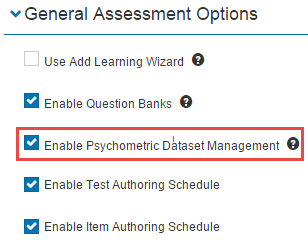
If this is checked then the functionality to manage Psychometric datasets is enabled and a Psychometric Data widget will be available in the widget bar for a Question details page.
When appropriate Users click the widget they activate a pop up box displaying any psychometric data linked to the Question.
Psychometric data is a more complex form of metadata that measures the performance of a Question. Additional complexities are:
A psychometric data set is similar to a Custom Attribute Set in that it contains the definition of fields that apply to Questions, and is applied at the Discipline level.
Click the General Assessment Options collapsible window to see this option.

If this is checked a Test Authoring Schedule collapsible window appears on the details page of a Test or Survey.
The Test or Survey Authoring Schedule only applies if there is a linked Workflow process. For further information, refer to the document on Workflows.

Click the General Assessment Options collapsible window to see this option.
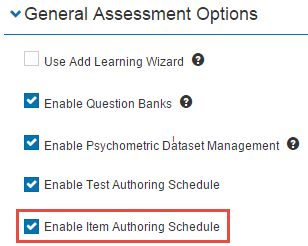
If this is checked a collapsible window appears on the details page of a Question.
The Item Authoring Schedule only applies if there is a linked Workflow process. For further information, refer to the document on Workflows.

Click the Question Options collapsible window to see the thirteen options that relate to Questions.
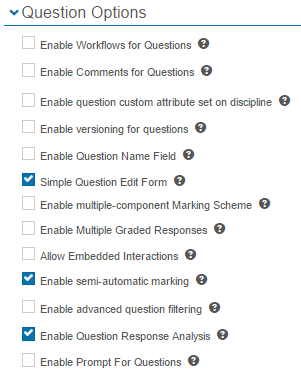
Click the Question Options collapsible window to see this option:

If checked Questions can go through a set of Workflow approval stages if they belong to an Assessment Module where Workflow status has been set.
This setting enables:
For further information, refer to the document on Workflows.
Click the Question Options collapsible window to see this option:

If this functionality has been turned on, there is a Comments collapsible window on the Assessment Question details screen. Comments can be reviewed and added to and are then available for others to view, like, dislike and reply to.
Comments are a useful tool if a workflow is enabled and Questions need to be studied and approved as part of a review process, particularly when there are multiple Users involved, see Assessment Question details.
Click the Question Options collapsible window to see this option:

If this is checked the ability to add Custom Attribute Sets to a Question becomes available.
This is configured from the Discipline Details page as the Custom Attribute Sets are defined for the whole Discipline. For further information, refer to the document on Custom Attributes.

Click the Question Options collapsible window to see this option:

If this is checked a Version number will be displayed for Questions. Versions numbers automatically increment when changes are saved or when Workflows are enabled and the state of a Question is changed
This number can be found next to the Identifier in the Question details page. For further information, refer to the document on Versioning.

Click the Question Options collapsible window to see this option:

If this option is checked then Questions must have a Name field as well as an Identifier.

Click the Question Options collapsible window to see this option:

If checked this limits the amount of detail that is shown in the Question edit form, removing: Discipline, Module, Identifier and Resources.
Click the Question Options collapsible window to see this option:

If this is checked the ability to specify multiple components in a Marking Scheme for manually marked Question Types (such as Short Answer) becomes available. You see this on the Question details page in the Marking collapsible window.

See see Assessment Question details for more information.
Click the Question Options collapsible window to see this option:

If this is checked it enables more advanced scoring options for Questions. For example a Multiple Choice Question could have marks set per distractor (possible answer) rather than just per correct or incorrect answer.
If this is checked then during Question creation you can click Scoring Type and find Per Distractor as an option in the drop-down list. If you select it you will notice that Min score and Max score appear and are outlined in red meaning that data must be entered.

Each possible answer (distractor) is allocated an individual score.
Click the Question Options collapsible window to see this option:

If checked this option allows the interactive part of a Question, for example, a Slider or Position Object, to be included in the middle of the Question stem. Thus, you could have text appear above and below a Question.
To use this feature select Insert>Insert Interaction within the Question Stem.

In the example below a Drawing Interaction Question type was designed with the Interaction inserted in the Question Stem. This enables one piece of text to be set above the Question and another below it.

Click the Question Options collapsible window to see this option:

This is an advanced marking option available for Keyword question types. It only works in conjunction with the Janison Extended Marking Plugin.
It allows a number of answer options to be set and, if any are entered, they are marked automatically. Answers that differ from these are marked manually. Contact the team at Janison for more information if required.
Click the Question Options collapsible window to see this option:

If checked the User can create a Question search filter and do more sophisticated searching in the Manage Questions screen and the Bulk Workflow Change Tool. The word Advanced appears in the bottom right-hand corner of the search menu as shown below and it links to a search functionality based on Boolean filters. For information about how to use these, refer to Building Filters.

Click the Question Options collapsible window to see this option:

If this is checked an additional collapsible window is added to the Question details screen. The Response Analysis window displays information about how the question has been answered, showing percentages per distractor and how many Users have attempted the question. The data source for the analysis is answers so there needs to be some Test Attempts to generate this data.
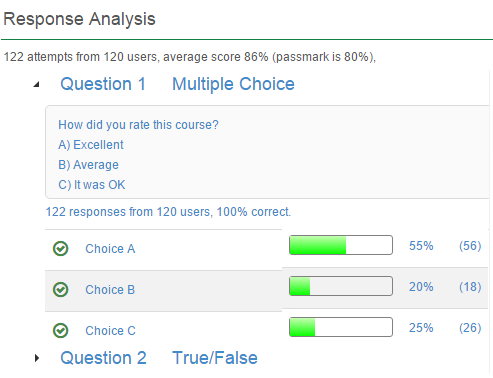
Click the Question Options collapsible window to see this option:

If checked this adds a Section to the Question creation page where information can be included as a prompt to help candidates answer correctly. If a prompt is not required in a Question, click Remove Prompt.

This section allows you to specify automatically generated Identifiers for the creation of Questions, Test Sections and/or Tests. The Identifiers follow a pattern that you specify in this section.
If you do not choose this option then the creation form for these three entities offers an Identifier field where you enter your own values, unless there is also a Name field.
To open this section click the Identifier Auto Generation collapsible window .
The process of specifying a pattern is the same for each the three entities. The instructions here will specify a pattern for Questions.
Check the Question Identifier Auto Generation checkbox and the options below it become active.

It is recommended that more than one token is selected. You can choose from tokens incorporating:
Each time you select another token it is added to the Question Identifier Pattern (2).
In this example Year(yy) is selected next and the pattern becomes [Module.name][yy].
Thus with this pattern, when you create a Question its Identifier would be:
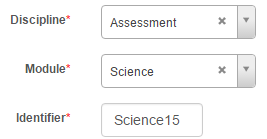
You can see above that this pattern would generate only one unique Identifier per Module per year.
This pattern needs to be increased by adding a number token such as Number (4 digits). The pattern would then become [Module.Name][yy][nnnn] and the Identifier would be:

Note that each 4 digit number will be unique (up to a limit of 9999 of course). In this example you must choose a number token that accommodates the number of possible Questions to be created per Module.
Check the box beside Auto Generated Identifiers are Read-Only if you do not want Users to be able to change such Identifiers once they have been generated by the system.
Click theTest Options collapsible window to see the options that relate to Tests.
Click the Test Options collapsible window to see this option:

If checked Tests can go through a set of Workflow approval stages if they belong to an Assessment Module where Workflow status has been set.
This setting enables:
For further information, refer to the document on Workflows.

For further information, refer to the document on Workflows.
Click the Test Options collapsible window to see this option:

The Jansion CLS allows for the customisation of the Skin (the settings for the colours, font, etc.) for the Test player. The default skin is used for the Test Player, as well as the Question and Test preview functions, unless this box has been checked and an alternative skin defined and selected.

Click the Test Options collapsible window to see this option:

When you click Increment version you will enter the current date in this field.
Click the Test Options collapsible window to see this option:

Enter the maximum size for an answer.
Click the Test Options collapsible window to see this option:

If this option is checked then the option This section has optional questions appears in the Randomisation and optional question drop-down list for an Assessment Test, see Randomisation and Optional Questions.

If you select this option in a test or Test Section then candidates choose a specified number of Questions from those offered, for example 2 out of the 5 optional Questions.
Click the Test Options collapsible window to see this option:

Contact the team at Janison if you require further information about this option.

Contact the team at Janison if you require further information about this option.
Click the Test Options collapsible window to see this option:

If this is checked the ability to add Custom Attribute Sets to a Test becomes available.
This is configured from the Discipline Details page as the Custom Attribute Sets are defined for the whole Discipline. For further information, refer to the document on Custom Attributes.
Click the Test Options collapsible window to see this option:

If checked this adds a Blueprint Settings collapsible window on the Test details page. It is unlikely you would want to use it. If you need further information, contact the support service team.
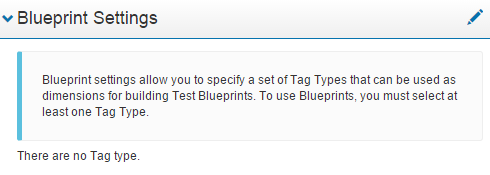
Click the Test Options collapsible window to see this option:

If this functionality has been turned on, there is a Comments collapsible window on the Test details screen. Comments can be reviewed and added to and are then available for others to view, like, dislike and reply to.
Comments are a useful tool if a workflow is enabled and Questions need to be studied and approved as part of a review process, particularly when there are multiple Users involved

Click the Test Options collapsible window to see this option:

If this is checked a Version number will be displayed for Tests. Versions numbers automatically increment when changes are saved or when Workflows are enabled and the state of a Test is changed
This number can be found next to the Identifier in the Test details page. For further information, refer to the document on Versioning.
Click the Test Options collapsible window to see this option:

If checked the User can create a Test search filter and do more sophisticated searching in the Tests and Surveys screen and the Bulk Workflow Change Tool. The word Advanced appears in the bottom right-hand corner of the search menu as shown below and it links to a search functionality based on Boolean filters. For information about how to use these, refer to Building Filters.
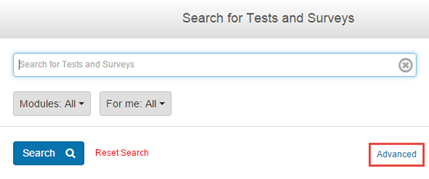
Click the Test Options collapsible window to see this option:

If this is checked an additional collapsible window is added to the Test details screen. The Response Analysis window displays information about how the Test has been answered.
Data includes the number of Test attempts, the average score as a % and then information about the responses to the Questions linked to the Test showing percentages per distractor and how many Users have attempted the question. The data source for the analysis is answers so there needs to be some Test Attempts to generate this data.

Click the Test Options collapsible window to see this option:

If this is checked the warning message about adding a newly created Test to a Catalogue Item so that learners can enrol in it will not appear. This is an appropriate setting for Authoring systems where Test and Question authors are not involved in this aspect of assessment delivery.
.
Click the Test Options collapsible window to see this option:

If this is checked the mark for each Question is displayed in the Test Player:
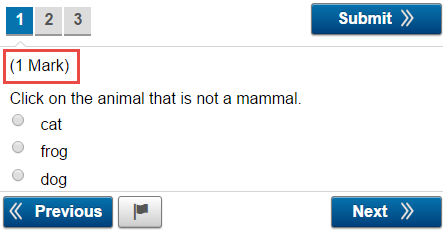
Click the Test Options collapsible window to see this option:

This sets the number of seconds between auto saves. If a number has been entered then answers to Short Answer question types are automatically saved at the specified interval. The valid range is between 20 and 600.
Click the Test Options collapsible window to see this option:

You are not advised to select this option.
It specifies that Questions that belong to the Module will appear in the search results for a Test or Test Section that is in a different Module. Such Questions could possibly be added to the Test but they would still need to be copied or moved into the Test’s Module before being linked to the Test.
For further information, contact the Client Service Team.
Click the Test Section Options collapsible window to see the ten options that relate to Test Sections.

Click the Test Section Options collapsible window to see this option:

If you check this option the checkbox below is available on the Test creation page. If checked the Test will be created with multiple Test Sections.

Click the Test Section Options collapsible window to see this option:

If this option is checked the Use Multiple Sections tick box will automatically be checked on the Test creation page.

It can be deselected if a single section Test is required.
Note that ‘Multi-Section Tests and Surveys’ must be enabled for this option to be available.
Click the Test Section Options collapsible window to see this option:

If this is checked then Test Sections can be reused across multiple Tests that all belong to the same Assessment Module.
The Sections collapsible window in a multi-section Test’s details page will now display other Test Sections belonging to the same Module and they can be linked to the Test.
Click the Test Section Options collapsible window to see this option:

If checked a Workflow status will display on the Test Section details page only if the Test Section is linked to an Assessment Module where Workflow status has been set. The following options become visible:
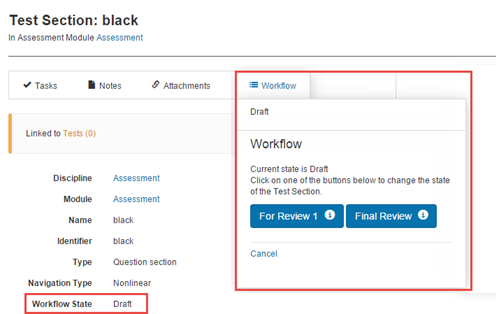
For further information, refer to the document on Workflows.
Click the Test Section Options collapsible window to see this option:

If checked you can specify random Question selection at a sub-section level.
The option to select this section has subsections that use random question selection is available in the drop-down list for an Assessment Test, see the topic on Randomisation and Optional Questions.

When this option has been selected the list of Questions can be divided into multiple subsections and random selections made from each subsection.
Click the Test Section Options collapsible window to see this option:

When this option is enabled a Test Section can be set to offer candidates linear or nonlinear navigation through Questions.

Nonlinear allows candidates to answer Questions in a Test Section in any order they like, rather than a strict linear order. It is set by default.
Click the Test Section Options collapsible window to see this option:

You are not advised to select this option. It specifies that Test Sections in a Module will appear in the search results for a Test that belongs to a different Module. Such Test Sections would still need to be copied or moved into the different Module before being linked to the Test. For further information, contact the Client Service Team.
Click the Test Section Options collapsible window to see this option:

If this is checked the ability to add Custom Attribute Sets to a Test Section becomes available.
This is configured from the Discipline Details page as the Custom Attribute Sets are defined for the whole Discipline. For further information, refer to the document on Custom Attributes.
Click the Test Section Options collapsible window to see this option:

If this functionality has been turned on, there is a Comments collapsible window on the Test Section details screen. Comments can be reviewed and added to and are then available for others to view, like, dislike and reply to.
Comments are a useful tool if a workflow is enabled and Questions need to be studied and approved as part of a review process, particularly when there are multiple Users involved.
Click the Test Section Options collapsible window to see this option:

If checked the User can create a Test Section search filter and do more sophisticated searching amongst Test Sections and the Bulk Workflow Change Tool. The word Advanced appears on the search menu and it links to a search functionality based on Boolean filters. For information about how to use these, refer to the document on Building Filters.

The CLS provides a number of question types for Learning Modules:
There is a much larger number of question types for Assessment Modules.
In this section you specify which of these types of questions are available for Assessment Questions, including where and how.
Click the Available Question Types collapsible window. There is a row for each type of Question. For simplicity this screenshot does not show them all:

There are several column headings and they do not all apply to every type of question Where they are relevant to the question type, a checkbox is present.
Test Sections are linked to Assessment Tests and are themselves linked to Questions, see the document on Test Sections. Here you will also find a description of different types of Test Sections, the role that they can play in the Test Player and the types of Questions that can be linked.
Click the Available Test Section Types collapsible window. There is a row for each type of Test Section and a column where you can check which ones will be available in your system.
. .
.
Document Flagging is essentially a way of drawing attention to assessment entities that need reviewing. This is particularly useful when Workflows are also enabled. Flags can also be used as a search term to locate Flagged entities.
Five entities can be individually Flagged:
A User with appropriate permissions clicks Flag This to Flag the entity:

This can be done by more than one such User. S/he can remove a Flag by clicking its button.
button.
Click the Document Flagging collapsible window to set Flagging up.
When the box is checked a User with appropriate permissions can Flag this kind of entity:

If you check the option Flags cleared by default on state transition then a User with the right to clear Flags will see a Clear flags checkbox during workflow state transitions.

The two drop-down lists allow you to select the required print template for use with printable Tests.
It is unlikely you will need these. For further information, contact the Client Service Team.

1300 857 687 (Australia)
+61 2 6652 9850 (International)
ACN 091 302 975
ABN 35 081 897 494
© 2024 Janison
Janison acknowledges the traditional owners of the land on which we work and meet. We acknowledge the continuous care of the land, animals and waterways. We pay our respects to Elders past, present and emerging.